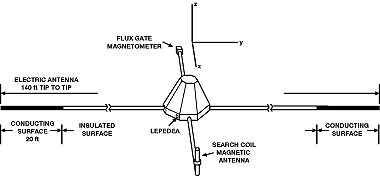

Online Data Plots
- High resolution magnetic field
- Two-day Summary Plots
- Four-hour Survey Plots
- Plasma Wave SFR Spectra
- Boundary layer crossings
- Despin Survey plots
The Hawkeye spacecraft (or Explorer 52) carried a payload of three scientific instruments: a plasma wave receiver, a fluxgate magnetometer, and a low energy proton-electron differential energy analyzer. It was designed, built, and tracked by personnel at the Department of Physics and Astronomy, University of Iowa. The spacecraft was launched on June 3, 1974 into a polar orbit with initial apogee over the north pole and re-entered on April 28, 1978 after 667 orbits or nearly four years of continuous operation. The spacecraft apogee was between 20.28 and 20.92 Earth radii with less than a 1.7 Earth radii perigee. The orbital period was 51.3 hours. During it's lifetime, the inclination of the plane of the spacecraft's orbit to the Earth's equator decreased monotonically from 89.81 to 81.85 degrees. The spacecraft's axis of rotation at launch was inertially fixed in its orbital plane, directed towards a constant right ascension and declination, and nearly parallel to the Earth's equatorial plane. The spacecraft was spin stabilized and had a rotational period of approximately 11 seconds.The broad science objectives of the Hawkeye spacecraft were to survey the high latitude polar regions (cusp, auroral zone, mantle, bow shock and magnetopause) of the Earth's magnetosphere. Hawkeye data contributed extensively to several new arenas of research with over 50 publications. For instance, over 10 scientific publications and four thesis discussed new features of auroral kilometric radiation, another 9 papers were on various aspects of very low frequency plasma waves; there were several papers each on the polar cusp, type III radio bursts, non-thermal continuum radiation, and various phenomena observed along auroral field lines such as the discovery of the auroral density cavity, and on observations of the Earth's magnetopause. These impressive scientific publications provided new and exciting details of the Earth's high latitude magnetosphere.
In 1992, Dr. James Van Allen (the Hawkeye Project Scientist) and the other Hawkeye principal investigators provided the National Space Science Data Center (NSSDC) with the high resolution digital data (referred to as Master Science Files) from Hawkeye. Recognizing the uniqueness of these data, the NSSDC has placed the entire Hawkeye data set in its on-line archive.
The three basic scientific instruments onboard the Hawkeye spacecraft are:
- VLF Plasma Wave Instrument (Dr. Donald Gurnett, PI). The Hawkeye VLF instrument used a long dipole antenna (42 meters tip-to-tip) for electric field measurements in 16 channels from 1 Hz to 178 kHz. The magnetic antenna was a search coil which was used to make magnetic field measurements from 1 Hz to 10 kHz.
- Low Energy Proton-Electron Differential Energy Analyzer or LEPEDEA (Dr. Louis Frank, PI). The LEPEDEA sampled electron and proton plasma spectra at 16 logarithmically spaced values extending approximately over the range 50 eV to 40 keV.
- Fluxgate Magnetometer (Dr. James Van Allen, PI). The Hawkeye magnetometer was a triaxial fluxgate instrument with four automatic range settings: 1150, 1450, 11500, and 125000 gamma (1 gamma = 1 nT). All three components of the magnetic field were measured.
To help the user in searching through the Hawkeye data set, summary plots of the entire Hawkeye archive have been generated. Each summary plot consists of an entire orbit's worth of data from all of the instruments, along with the spacecraft position. Solar wind plasma pressure and IMF data have been added to the plots to help the user in data selection.Having identified a data interval of interest, the user will want to request the data from NASA's Data Archive and Distribution Service (NDADS). The Hawkeye data is stored online and can be easily and rapidly obtained electronically by following the simple NDADS data request procedure.
Although the Hawkeye data set is more than twenty years old, important discoveries are still being made using the data. This is due to the uniqueness of the Hawkeye orbit, being only one of two spacecraft with a high inclination orbit (near 90 degrees) that cut through the Earth's magnetopause and bow shock. Exciting, newly discovered observations by the Hawkeye spacecraft can be viewed in recent results.
 NASA
home page
NASA
home page
 GSFC organizational page
GSFC organizational page
James L. Green
Space Science Data Operations Office
NASA Goddard Space Flight Center
Greenbelt, MD 20771, USA
(301)286-7354
green@nssdca.gsfc.nasa.gov
Scott Boardsen
EITI
NASA Goddard Space Flight Center
Greenbelt, MD 20771, USA
(301)286-0837
boardsen@xfiles.gsfc.nasa.gov